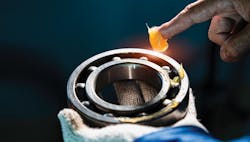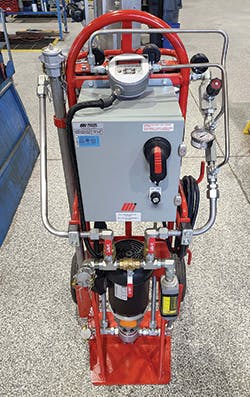Implementing a predictive lubrication reliability strategy
Corporate reliability teams and their respective plant site personnel will be able to capture tangible returns within months of implementation, beginning with understanding why lubrication is important. Next would be expanding toward building a predictive lubrication reliability strategy and implementing solutions. Improving lubrication reliability equipment will live in the front half of the P-F curve (which shows potential failure and functional failure) and achieve life extension upwards of three to eight times.
Put your strategy where your mouth is
Business strategies must evolve and adapt as the global demands change. 2020 was the most difficult, demanding year many have ever experienced. Several industry verticals were forced to run over capacity to keep up with demand, with maintenance tasks handcuffed to “as necessary” or “only if it breaks.”
A year later, maintenance tasks have been changed forever. Companies are taking two approaches. The first is maintenance avoidance. “Do those PMs really need to get done? After all, we skipped it for one year and didn’t have any issues.” The second is maintenance and reliability enhancement. Does technology exist to provide insight into machine health diagnostics? Every organization quantifies the expense versus reward, and it is crucial to have a hand in the game to stay competitive and become a sustainable organization.
Predictive maintenance business strategies often focus on minimizing the financial impact of a failure. A significant area of opportunity is lubrication reliability. The best part is that lubrication reliability is achievable within every organization. Yes, every organization has the same opportunity!
What is the secret? The strategy of obtaining this success is simple. It has been stated in many lubrication-related articles over the past ten years: Educate an organization’s human capital to provide a foundation of why lubrication is important, and invest in the tools (contamination control mechanisms)—the how. Simple, right? It is well known that organizations have heard about this strategy and have failed to execute. Why? Sustainability was never the end goal. It was about a one-time objective instead of a living program that involved active participation and investments in controlling equipment reliability and asset health.
Creating a sustainable predictive lubrication reliability program can dramatically affect business costs and result in significant cost avoidance. According to a 2020 study by technology market research firm Vanson Bourne, approximately $50 billion is lost due to unexpected downtime and, using the 58% of bearing failure statistic, a significant amount of cash outflow is preventable. Understanding what is achievable, what tools exist, and how to manage those tools is key to continue building success.
Today’s buzz is around Industry 4.0. By leveraging this technology to supplement ordinary tasks and inspections allows key personnel to focus on additional value-add tasks. Notice the words “additional” and “value-add.” Many believe it is a direct replacement, but this is not the case. The value of using technology is to focus on more important, challenging issues. Also, it removes ambiguous notions because the data speaks for itself. Identifying value is no longer difficult as the tools can speak in business terms (lost production hours, cost per failure, etc.).
Lubrication for machineries: Focused on small/medium machines and bearings
Lubrication solutions and services to simplify best practices
Bring a new lubrication specialist on board
Bringing data to your team
Production key performance indicators (KPIs) are well known in every plant, yet we have limited visibility into lubrication reliability KPIs. Some well-known critical KPIs involve qualifying the level of lubrication training individuals have, categorizing the amount and types of lubrication-related failures, documenting lubrication-related tasks, identifying health and safety measures with waste oil, and monitoring machine/oil health through condition-based techniques and technology. These all influence lubrication reliability and have an impact on a program’s sustainability.
Below are three KPIs that provide the clearest path to a return on investment:
1. Qualifying the level of lubrication training. Education is the first step of every process. Without the why, the correct implementation method—the how—will not be achieved. Lubrication can be done the wrong way. A common example is greasing. If you give someone a grease gun and say, “Go grease a bearing,” the user will grease a bearing until grease comes out. Is this right? In their defense, such users know no different, nor do they understand the impact of overgreasing a bearing. On the other hand, if they know why grease should not be expelling out of the bearing seal, they will only apply the appropriate amount of grease. It is recommended that all personnel attend at least four hours of lubrication training a year with key specialists who hold lubrication certifications of MLT I/MLA I and MLA II.
2. Categorizing the amount and types of lubrication-related failures. Identifying lubrication-related failures will provide insight into the defects that are causing equipment wear and potential failure. Common wear mechanisms include abrasion, erosion, and fatigue. These mechanisms are the most influenced by the defect of particle contamination. Erosion is also influenced by the defect of water contamination.
Another failure mechanism is adhesion. This is commonly caused by inadequate lubricant protection.
3. Monitoring oil health through condition-based techniques and technology. The most common way to extend equipment reliability is to protect it against factors that cause it to fail. When establishing how lubrication-related wear mechanisms can contribute to failure, solutions exist to ensure those events do not occur. With wired or wireless technology, seeing results is now at the fingertips of technicians, engineers, business managers, etc. Achieving sustainable business practices is now possible and will become the new normal.
Being disconnected from machines on the plant floor is the past. Today, the following solutions provide connectivity, real-time analytics, continuous feedback, and alerts:
- Ultrasonic Auto-Luber—This sensor is designed for grease applications and will provide grease until specific ultrasonic levels are met.
- Connected Desiccant Breather—This sensor is designed for oil-lubricated rotating machinery and will capture critical size particles (3 microns) and prevent or remove moisture from the air. Another essential component to this is understanding where moisture comes from. When moisture is highly concentrated with a machine, the direction of saturation from the top-down will allow you to take immediate action. It is most common for water to make its way into a system through a cooling loop, unsealed port, new oil additions or a seal. Additionally, this sensor measures temperature of the active headspace.
- Oil Quality Sensor—This sensor is designed for oil-lubricated rotating machinery and provides trendable readings showing the remaining useful life of a lubricant, oil degradation curve, and oil temperature. Its approach of utilizing the TDN (Tan Delta Number), measuring the chemical shift within the lubricant provides insights into how quickly oil is degrading and when the lubricant should be changed. Issues such as moisture, dirt, process contamination, TAN (total acid number), TBN (total base number), wear particles, or viscosity changes will affect the readings allowing notification of when issues arise. Lubricant filtration or changeout is the most common action item.
- Contamination Monitoring Sensor—This sensor is designed for oil-lubricated rotating machinery and will provide a sensor-calibrated ISO 4406 code to elaborate on the particle sizes present within your oil. Ideally, it allows you to see the size distribution and understand the next action to be taken (see Figure 1). Filtration is a common action item.
- Wear Debris Sensor—This sensor is designed for oil-lubricated rotating machinery and will provide ferrous wear debris data; it supports detecting imminent failure through continuous wearing metal surfaces. In conjunction with the contamination monitoring sensor, this will support the wear particle size. Filtration and the scheduling of repair or replacement are the common action items.
Utilizing technology to achieve results is now and the future. Making an impact within an area of a plant or corporate organization requires data to make better decisions. We have always trusted but verified—and now we have the tools to do so in a timely manner.
Where do we go from here?
A well-defined strategy without execution is useless. Execution requires resources to design an implementation plan to realize a return on investment. Technology is becoming smarter and exists for any type of machine. In the lubrication reliability space, the technology mentioned above is becoming widely adopted. There is no one-size-fits-all package, and identifying the correct solution for an application requires due diligence and understanding of the objectives. Not all equipment will fall into the predictive maintenance category due to repair costs.
To begin this journey:
- Start with the strategy. Support the education and tools to achieve results.
- Identify a partner that can provide all aspects of education and technology, and document return on investment. A trusted partner will guide your hand along this journey and fill in where gaps exist.
- Identify a plant with 20 to 40 critical machines.
- Secure a walkthrough with a trusted partner.
- Implement the tools and create biweekly check-ins to review the data.
- Capture and share success. Too often, success is documented but not shared. Build posters, create incentives, make well-known the efforts and the results you have achieved.
Failure can be controlled and occurs as often as we allow it to. Diving deep to eliminate contributing factors (a.k.a., defects) provides results and peace of mind for every reliability and maintenance professional.
This story originally appeared in the August 2021 issue of Plant Services. Subscribe to Plant Services here.


